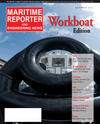
Page 72: of Maritime Reporter Magazine (November 2011)
Feature: Workboat Annual
Read this page in Pdf, Flash or Html5 edition of November 2011 Maritime Reporter Magazine
and outcomes in order that a processof continual improvement can be en- abled.Provide an on-line community to sup- port the trainers ensuring the sharingof best practices, improving trainer buy-in, and enabling the mentoring of new trainers. BENEFITSWhile the advantages of SEA at BC Ferries are numerous, the primary bene-fits are standardization, objectivity, more effective familiarization period, and heightened insight into the educationalprocess and outcomes.Standardization. Standardization is ar- guably the primary benefit. Traditional job shadowing, despite its positive as- pects, suffers from the drawback of per- petuating suboptimal practices; traineesinheriting the bad "habits" of the personbeing shadowed. The SEA process greatly reduces the incidence of this intwo ways. First, all phases of the process are supported by company-vetted best- practice learning materials. During self-study, trainees are learning only standardized lessons created by BC Fer- ries. Second, during on-board familiar- ization, trainees are being taught bydedicated trainers who have themselves been trained as adult educators and aresupported by company-created familiar- ization materials. All of the company-vet- ted, standardized learning and supportmaterials are available on the LMS dur- ing training, and after to support themariner throughout their career at BCFerries.Objectivity : Objectivity is enhanced at BC Ferries through a more formal clear- ance process. Clearance at BC Ferries inthe past involved a senior employee test- ing the candidate with the support of achecklist. If the senior employee felt the candidate understood the item on thechecklist, a mark was placed on that item and testing moved on to the next item. This is a very common approach, but suf- fers from a great degree of variability in terms of what constitutes "understand- ing". The SEA process formalizes the clearance process by adding requireddemonstrations proving the capability of the candidate, an oral "scenario" basedexamination, a meeting with the Master, and finally, a written multiple-choice exam which is randomized and delivered by the LMS. Written exams are unparal- leled at objectively assessing knowledge, and therefore form one of the main pil-lars of objective assessment in the SEA program.Effectiveness : The on-board familiar- ization phase is one of the greatest dif-ferences compared with the old practiceof job shadowing. First, it is now pre- ceded by the self-study phase. One effect is that now trainees arrive on-board with a uniform level of knowledge which did not exist before. This allows on-board fa- miliarization to be far more effective and direct. Candidates already have the "knowledge" and are now acquiring the "experience" onboard. In addition, be- cause the on-board familiarization is now led by a dedicated trainer, the trainees re- ceive undivided attention and intense in- struction. The combined effect is that the on-board education duration has been re-duced from a variable period of one or two weeks to a predictable 5 days. Insight: Finally, there is now a level of oversight and analysis in the educational process which was not previously avail- able. Most of this comes from the em-ployment of the learning management system, MarineLMS. For example, learn- ing page access logs indicate, on average, how long learners are spending on the 72Maritime Reporter & Engineering News FEATURE TRAINING & EDUCATION MR Nov.11 # 9 (66-73):MR Template 11/7/2011 2:53 PM Page 72

 71
71

 73
73
